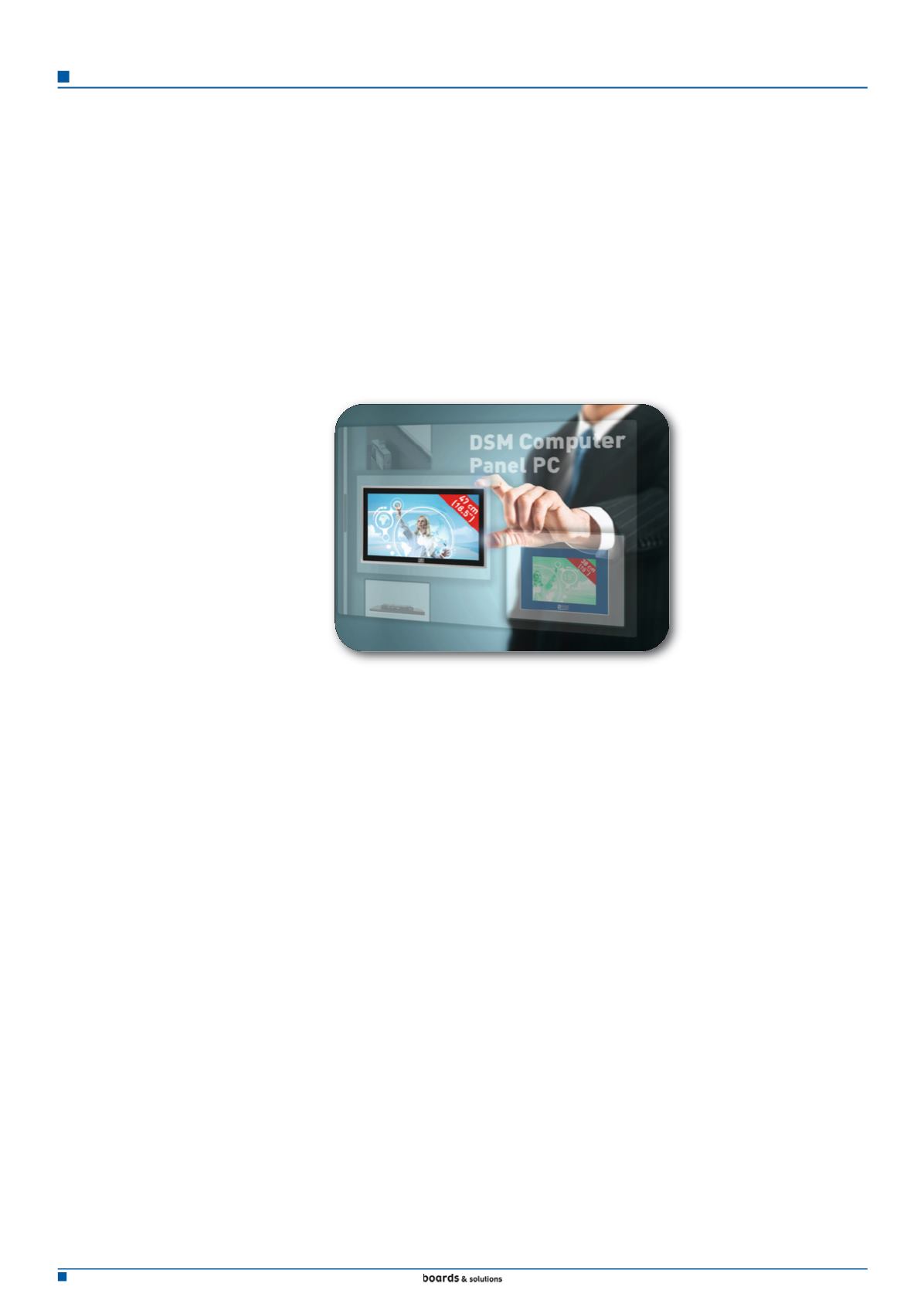
The Apple iPad and the Apple iPhone were
the pioneers. Thanks to modern tablet PCs
and smart phones, every user is now familiar
with modern touch screen technologies as a
human-machine interface. The touch screen
as intuitive input/output medium can be op-
erated very effectively with a finger or a point-
er. And we do not want to forgo the advantages
of this simple human machine interaction
(HMI), to which we have quickly become ac-
customed, for the operation of industrial dis-
plays and panel PCs. Nowadays, various
proven touch screen technologies are available
for deployment depending on the display ap-
plication. A touch screen consists of a touch
sensor, a touch controller for processing the
signal and a software driver. The surface of
the touch sensor is made of optical glass or a
flexible polyester. Touching the surface pro-
duces, for example, a resistance or field change
that can be used to determine the touched
position.
The resistive single-touch technology that re-
quires pressure produced by a finger or some
other object on the surface is the most popular
technology (figure 1). The touch-sensitive sur-
face consists of two conductive layers made of
indium tin oxide (ITO). The opposing layers
are separated from each other using small
spacers. Whereas the rear layer is applied on a
stable surface, the front layer is normally on a
flexible polyester. A small test voltage for
control purposes is applied to both ITO layers.
When the flexible polyester is touched, both
layers are pressed together and a current flows
briefly. The resulting voltage change allows
the position of the pressure point to be deter-
mined exactly. Simple 4-wire technology in-
cludes four channels that serve as connection
to the controller, where both ITO layers are
used to determine the contact point. 5-wire
technology achieves a higher accuracy.
The most powerful argument for the use of
touch screens is their low cost of manufacturing.
The precision of the position determination
suffices for many applications. Any object can
be used to operate the touch screen, even a
gloved hand. The flexible polyester layer, how-
ever, is subject to wear because of the mechan-
ical force. Touch screens have a high resistance
to dirt and are largely resistant to spilt liquids,
aggressive chemical cleaning agents and other
external effects, such as grease, moisture, dust
and dirt.
Resistive touch technologies are increasingly
being replaced with projected capacitive touch
(PCT or PCap) touch screens that do not re-
quire any force on the surface (figure 1). The
displays integrate a dual-layer coordinate net-
work consisting of electrodes that use voltage
to produce a uniform electrical field. Touching
with a conductive object issues a charge trans-
port that causes the electrostatic field between
the electrodes and the capacitance to change.
Because the capacitance in the complete coor-
dinate network is measured continually and
the inputs of the individual fingers can be reg-
istered separately, capacitive touch screens
offer multi-touch capability. For the PCT tech-
nology, a glass plate is placed in front of the
display. The ITO layer is located on the rear of
the glass plate and projects the capacitive field
to the glass plate. The relatively expensive PCT
touch screens are very resistant to dirt, heat,
cold and moisture and more robust than resis-
tive systems (table 1). Even scratches in the
surface do not impair their function. The glass
surface increases the service life greatly and,
depending on the controller setting, also per-
mits operation with thin gloves. Outdoor de-
ployment is possible.
Nevertheless panel PCs with resistive single-
touch screens are still very popular in the au-
tomation market and, thanks to their many
advantages, continue to be ideal for some
future applications. The monitors normally
have a width-height ratio of 4:3 or 5:4. For
this reason, DSM Computer also offers two
new panel PCs with single-touch. Panel PCs
with 15" or 17" display diagonals and resistive
single-touch are still the high runners in the
market. Modern design and flat construction
Panel PCs transition to single-touch,
multi-touch, and widescreens
I
NDUSTRIAL
C
OMPUTING
By Christian Lang,
DSM Computer
The new Panel-PC family
from DSM Computer includes
not only systems with 43 cm
and 38 cm diagonal
single-touch screens but also
a 47 cm widescreen with
LED backlight and
multi-touch. Which
panel PC suits which
applications?
October 2013
22


